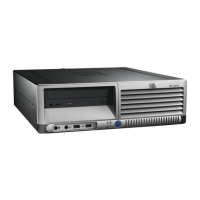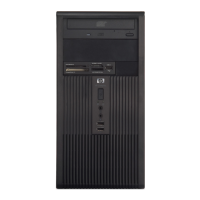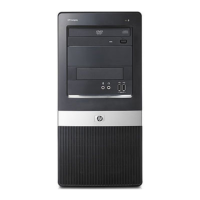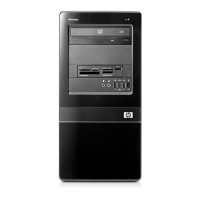Short description Details Solution
until the Admin tool is closed. If user
clicks No in that dialog box, then the
Admin tool does not open at all and
uninstall proceeds.
Intermittent system lockup
occurs after creating PSD
on 2 users accounts and
using fast-user-switching
in 128-MB system
configurations.
System may lock up with a black screen
and non-responding keyboard and
mouse instead of showing welcome
(logon) screen when using fast-switching
with minimal RAM.
Root Cause suspicion is a timing issue in low memory
configurations.
Integrated graphics uses UMA architecture taking 8 MB
of memory, leaving only 120 available to user. This 120
MB is shared by both users who are logged in and are
fast-user-switching when error is generated.
Workaround is to reboot system and customer is
encouraged to increase memory configuration (HP
does not ship 128-MB configurations by default with
security modules).
EFS User Authentication
(password request) times
out with access denied.
The EFS User Authentication password
reopens after clicking OK or returning
from standby state after timeout.
This is by design—to avoid issues with Microsoft EFS,
a 30-second watchdog timer was created to generate
the error message).
Minor truncation during
setup of Japanese is
observed in functional
description
Functional descriptions during custom
setup option during installation wizard
are truncated.
HP will correct this in a future release.
EFS Encryption works
without entering password
in the prompt.
By allowing prompt for User password to
time out, encryption is still capable on a
file or folder.
The ability to encrypt does not require password
authentication, since this is a feature of the Microsoft
EFS encryption. The decryption will require the user
password to be supplied.
Secure e-mail is
supported, even if
unchecked in User
Initialization Wizard or if
secure e-mail
configuration is disabled in
user policies.
Embedded security software and the
wizard do not control settings of an e-
mail client (Outlook, Outlook Express, or
Netscape)
This behavior is as designed. Configuration of TPM e-
mail settings does not prohibit editing encryption
settings directly in e-mail client. Usage of secure e-mail
is set and controlled by 3rd party applications. The HP
wizard allows linkage to the three reference
applications for immediate customization.
Running Large Scale
Deployment a second
time on the same PC or on
a previously initialized PC
overwrites Emergency
Recovery and Emergency
Token files. The new files
are useless for recovery.
Running Large Scale Deployment on any
previously initialized HP ProtectTools
Embedded Security system will render
existing Recovery Archives and
Recovery Tokens useless by overwriting
those xml files.
HP is working to resolve the xml-file-overwrite issue
and will provide a solution in a future SoftPaq.
Automated logon scripts
not functioning during user
restore in Embedded
Security.
The error occurs after user
●
Initializes owner and user in
Embedded Security (using the
default locations—My
Documents).
●
Resets the chip to factory settings
in the BIOS.
●
Reboots the computer.
●
Begins to restore Embedded
Security. During the restore
process, Credential Manager asks
Click the Browse button on the screen to select the
location, and the restore process proceeds.
30 Chapter 8 Troubleshooting ENWW

